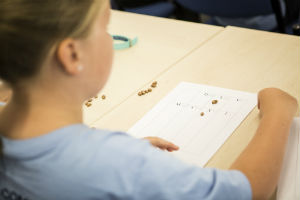Ancient Roman teaching methods help modern school children learn maths
Release Date 06 July 2017

Schoolchildren from across the region have been learning different ways to engage with maths, as part of a series of ancient Roman classroom days held at the University of Reading.
Organised by the University's Department of Classics, the Reading Ancient Schoolroom event saw pupils undertake a series of ancient-style school exercises, including doing multiplication, division, and calculating compound interest with Roman numerals. A key difference between how maths was taught then and now is that sums were not written down in ancient Roman times - instead an abacus or a counting board with dried beans was used.
In addition, school children in antiquity were taught individually by the teacher and worked on their own assignments, rather than being taught as a whole class. This meant pupils were able to work at their own rate of ability.
Professor Eleanor Dickey, who organised the series of events, said: ‘We've been running these ancient schoolroom days for a few years now and what we've learnt during that time is that the children really engage with the ancient teaching methods, especially when it comes to maths. We've found that children who aren't naturally gifted at maths actually enjoy using the abacus and counting boards and this helps to stimulate their interest and learning of the subject.
"As follow up to the day we provide teachers with a pack of teaching materials they can take back to their own classroom and this includes instructions on how to make a counting board, as well as other maths-related and non-maths-related activities. It is my hope that some of these ancient methods can help to further modern teaching practice."
Other activities on the day included reading poetry written without word division or punctuation, learning to write with a stylus on a wax tablet and reading from papyrus scrolls. Wearing Roman costumes, students also got to sample some authentic Roman food and handle objects from the University of Reading's Ure Museum of Greek Archaeology.
Professor Dickey continued: "Ancient education methods, by being very different from our own, help us better appreciate both the advantages and the disadvantages of our own system, and show that doing things our way is neither natural nor inevitable.
"The ancient Roman school days are also a great way to get children interested in history more generally."
The research which helped determine what a day in an ancient Roman classroom was like came from Professor Dickey's discovery and translation of a set of ancient textbooks describing what children did in school. Parts of these historical records were published last year in a book by Professor Dickey: Learning Latin the Ancient Way: Latin Textbooks in the Ancient World, published by Cambridge University Press.